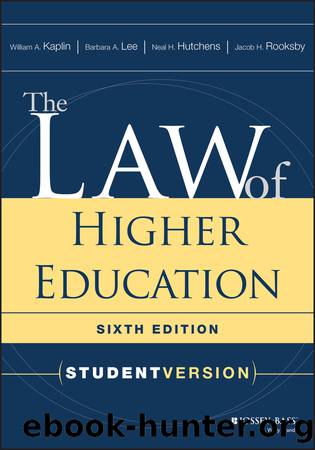The Law of Higher Education, Student Version: Student Version by unknow

Author:unknow
Language: eng
Format: epub
Publisher: John Wiley & Sons, Incorporated
Published: 2020-03-17T00:00:00+00:00
Section 7.5. Campus Computer Networks
7.5.1. Freedom of speech.âIncreasingly, free speech on campus is enhanced, and free speech issues are compounded, by the growth of technology. Computer labs, laptops, campus networks, servers, and internet gateways have assumed a pervasive presence on campus and are used increasingly by the campus community for social media communications, discussion groups, web pages, research, access to information on campus programs and services, and entertainment. Studentsâthe focus of this sectionâmay be both senders (speakers) and receivers (readers); their purposes may be related to coursework or extracurricular activities, or may be purely personal; and their communications may be local (within the institution) or may extend around the world.
Further developments on the pervasiveness of computer communications have involved social networking sites that students commonly use to communicate with many other persons. Since the sites are often completely separate from the institution's own networks and systems, these communicative activities are typically considered to be âoff campus,â and questions may be raised about the institution's authority to regulate them. Yet these communications may target other students at the institution, as well as faculty members and administrators or the institution itself, in ways that create actual or potential harm to the individuals involved or the institution.
Most of the cases thus far on students and social networking sites have involved elementary and secondary education. See, for example, J.S. ex rel. Snyder v. Blue Mountain School District, 650 F.3d 915 (3d Cir. 2011) (en banc); Layshock ex rel. Layshock v. Hermitage School District, 650 F.3d 205 (3d Cir. 2011) (en banc). The elementary and secondary education cases have raised issues concerning schools' authority to regulate âoff-campusâ speech, the application of the Tinker âmaterial and substantial disruptionâ standard (see Section 9.4.1 of this book), and the application of the âtrue threatsâ doctrine (see discussion later in this section, under âquestion 2â).
Tatro v. University of Minnesota, 800 N.W.2d 811 (Minn. App. Ct. 2011), affirmed on other grounds, 816 N.W.2d 509 (Minn. 2012), is an illustrative higher education case. A mortuary science student posted a statement on Facebook that she wanted âto stab a certain someone in the throat with a trocar,â along with other statements that intimated a level of disrespect for the sanctity of the donor bodies used for student training. When the university disciplined the student, she claimed that her Facebook statements were protected free speech. The student emphasized that her statements were not made on a university computer network or on any online forum created by the university and that her statements did not constitute a âtrue threat.â The intermediate appellate court determined, however, that if the student's speech had disrupted the mortuary science program, the university had an interest in disciplining the student and in doing so before the speech reached the level of a âtrue threat.â The court noted that some professors believed the student's statements referred to them and that at least one professor was visibly shaken due to fear that resulted from the postings.
Then, using the Tinker material and
Download
This site does not store any files on its server. We only index and link to content provided by other sites. Please contact the content providers to delete copyright contents if any and email us, we'll remove relevant links or contents immediately.
| Air & Space | Construction |
| Disability | Educational Law & Legislation |
| Labor Law | Maritime |
| Military | Personal Injury |
| Sports |
Steroids: History, Science, and Issues by Standora Joan E.; Bogomolnik Alex; Slugocki Malgorzata(1192)
A Practical Guide to International Arbitration in London by Hilary Heilbron(1084)
Adrift by Steven Callahan(1030)
Reclaiming History by Vincent Bugliosi(1019)
Persuasion by Owner(1012)
The Nuremberg Interviews by Leon Goldensohn(989)
Dog Company: A True Story of American Soldiers Abandoned by Their High Command by Lynn Vincent & Roger Hill(978)
40 Days and 40 Nights by Matthew Chapman(966)
Poisoned by Jeff Benedict(958)
Last Narco by Beith Malcolm(936)
The New Whistleblower's Handbook by Stephen Kohn(921)
Introduction to the study and practice of law in a nutshell by Kenney F. Hegland(894)
Kafka's Last Trial by Benjamin Balint(847)
Lincoln's Code by John Fabian Witt(840)
A Passing Fury by A. T. Williams(825)
Japanese War Crimes during World War II: Atrocity and the Psychology of Collective Violence by Frank Jacob(810)
Eichmann in Jerusalem by Hannah Arendt(798)
Dog Company: A True Story of American Soldiers Abandoned by Their High Command by Roger Hill & Lynn Vincent(794)
A Court of Refuge by Ginger Lerner-Wren & Rebecca A. Eckland(785)
